by John Butcher
The estimable Jim Bacon suggests that the Northam administration’s emphasis on “equity” and “restorative-justice” is keeping disorderly students in the classroom to the detriment of the other students. As well, he posits that behavior problems are more common among black students so the effect should be larger in divisions with larger black populations.
VDOE has some data that might speak to those issues.
Elementary and middle school students mostly take the same tests at the same time. High school, not so much. So let’s look at the data for the elementary and middle school grades.
First, the disorder. The Safe Schools Information Resource goes back to 2015. For grades 3-8, the statewide counts there of individual offenders as a percentage of their ethnic population are:
In absolute terms, the 2019 rate of individual offenders for black students, 16.4% is 9.2% higher than the all students rate of 7.3% while the white students’ rate is 2.8% below.
All three rates increased from 2015: All students by 0.7%, black by 0.8%, and white by 0.6%. That is consistent with the Bacon hypothesis and it confounds any notion that the government’s actions are reducing disorder in our schools.
The picture in Richmond is less definitive.
Contrary to the state averages, all three of Richmond’s offender rates decreased after 2016, all students by 6.1%, black by 4.4%, and white by 2.2%
But then there is Fairfax County.
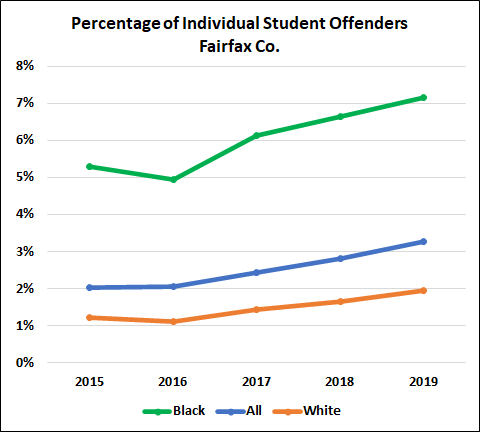
Overall, the Fairfax rate rose by 3.3% (61.5% of the 2015 rate); the black rate increased by 1.9% (35.3% of the ‘15 rate); the white rate, 0.73% (59.9% of the 2015 starting point).
It is tempting to assign the huge increases in the offender counts in Fairfax to the emphasis there on “restorative-justice (pdf)” and “equity.” The smaller increases statewide offer a lesser but still enticing temptation. No telling what those Richmond decreases mean but with a 2019 offender rate of 17.5%, 2.4 times the state average of 7.3%, the only sensible inference is that’s it’s past time to move one’s family to one of the nearby counties.
For sure, something awful is going on in Richmond schools and something is getting worse statewide, much worse in Fairfax.
To look for the possibility of an “equity” effect on performance, let’s turn to the SOL pass rates.
The big two SOL tests are reading and math. First, the state average pass rates on the reading tests.
he large drop in 2013 came from new, tougher tests. Those new tests also exacerbated the black/white performance gap.
To the point here, these data show slightly improving pass rates for both black and white students in the first years after the new tests but faltering rates in 2019. During the same period, the gap between black and white students improved (decreased) by 4.0 points, a significant amount, albeit virtually all the improvement came during the recovery, such as it was, from the new tests.
On the math tests, the big drop came with new, tougher tests in 2012. More recently, the pass rates were faltering until they enjoyed a bounce in 2019 from newer, easier tests. Also in the recent period the black/white gap was worsening slightly but improved a bit with the easier tests.
(There’s a template for making the entire school system look better: Just water down the tests every year.)
The black/white difference improved by 3.4 points from 2013 to 2019 with, again, most of the improvement coming before the “equity” campaign.
If the Governor has had any effect on pass rates, it’s not obvious here. So let’s turn to a couple of the more interesting divisions.
Richmond has one of the largest percentages of black students in the state.
(2019 data. Race group names abbreviated; Am. Indian and Pacific Islander groups both < 0.5% and omitted to simplify the graph).
Or, in terms of the black/white ratio,
The Richmond reading data tell a sorry story.
There’s no recent improvement in the Richmond rates; indeed, the (already appalling) rates for the black students have declined some in the last three years while the black/white gap worsened by 9.5 points. That gap now stands at 39.3, 188% of the state average gap.
On the math tests, the Richmond gap has deteriorated consistently since 2014, landing at 35.9% in 2019.
Turning to Fairfax, a County that has been a leader in the restorative-justice (pdf) movement.
The racial distribution in the Fairfax schools is different from the state average and quite different from Richmond.
Both black and white students in Fairfax consistently beat the state averages for their groups but the black/white gaps closely track the state numbers.
These data suggest that the “equity” movement in the Virginia’s schools has not improved pass rates on the elementary and middle school reading and math tests and has generally failed to halt ongoing deterioration of the black/white rate gaps.
The recent, general decline of these pass rates, except under the new, easier math tests, is consistent with increasing disorder in the classrooms but does not establish a causal relationship.
On these data, Bacon is batting at least .750:
- Keeping disorderly students in the classroom: Number of offenders is rising;
- To the detriment of the other students: Pass rates are falling;
- Behavior problems are more common among black students: Astronomically;
- The effect should be larger in divisions with larger black populations: Not so, at least on this very small sample of divisions.
Because of the very small number of divisions in the sample here, I need to look at the data for all the divisions. Stay tuned.

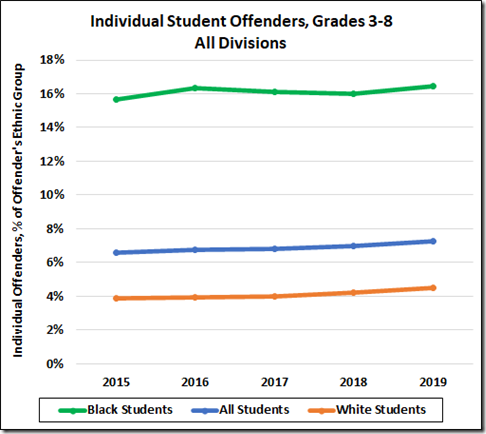
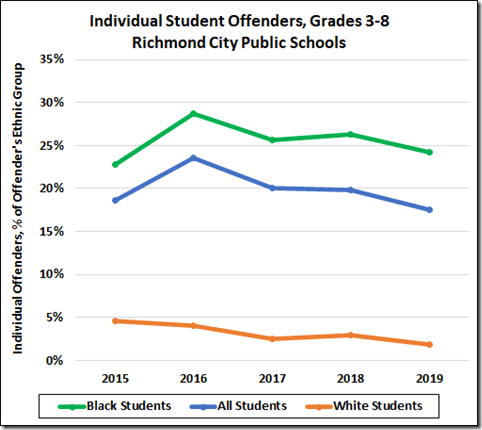
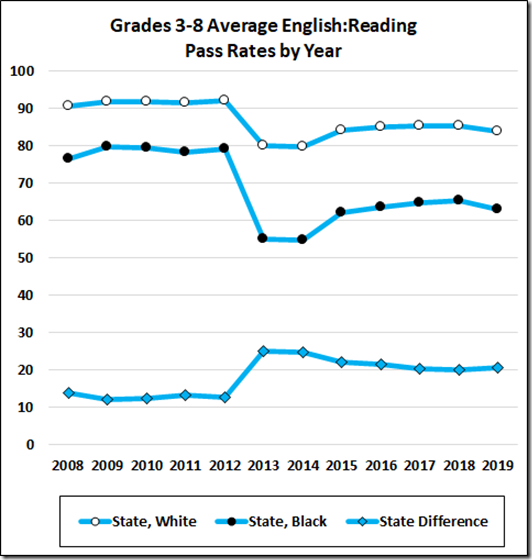
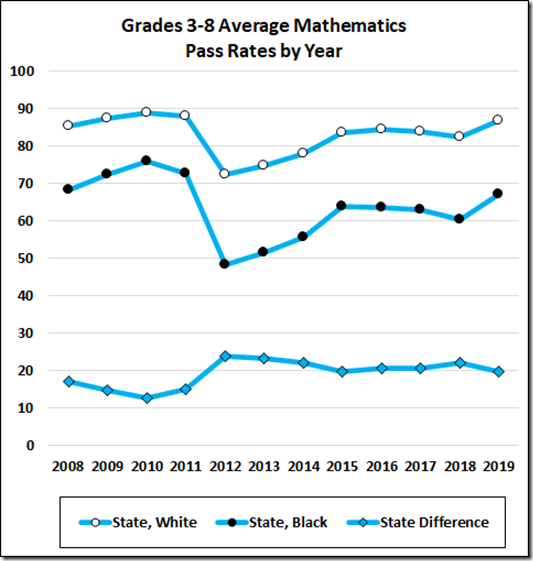
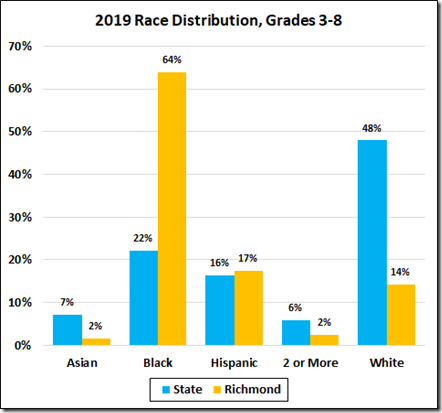
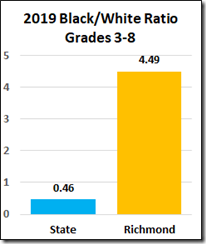
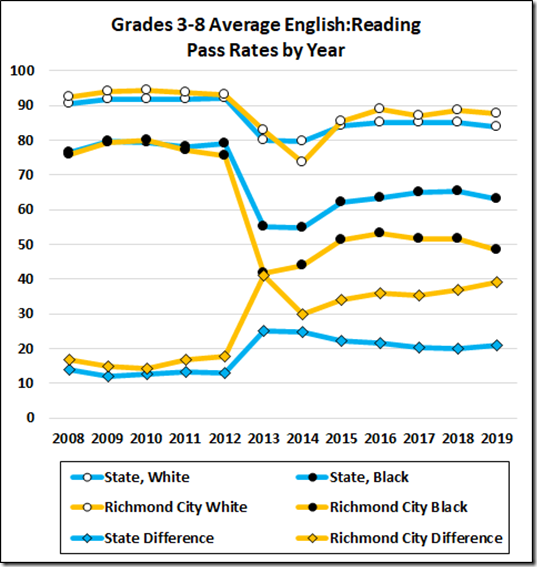


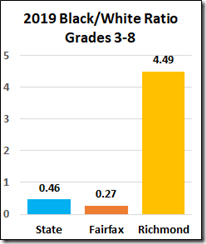


Leave a Reply
You must be logged in to post a comment.